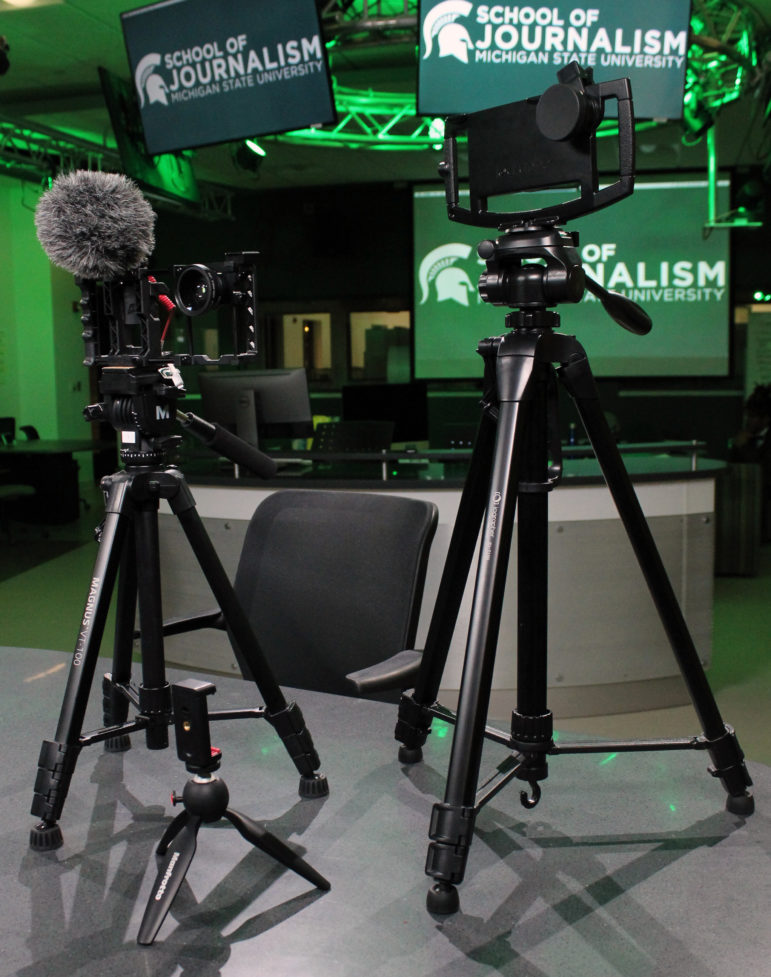
Jeremy Steele / Michigan State University School of Journalism
The right equipment can help you produce high-quality work for publication or broadcast by School of Journalism, campus and/or professional media outlets.
School of Journalism faculty members have put together this guide to provide some general standards – and to recommend some specific equipment – to help you build a mobile reporting kit. New products are being introduced all the time; our recommendations should not be considered the only good options. Look for equipment that meets the basics standards we discuss and fits your available budget. We will periodically update our recommendations based on equipment availability and the hands-on experiences of students and faculty.
Please be aware that some classes may require specific equipment beyond that listed here. Talk to your professor before you make a big purchase.
In addition to your smartphone, at a minimum your mobile reporting kit should include:
- a smartphone mount, clamp or rig that allows you to attach your device to a tripod
- an external microphone
- a tripod
Note: Vendors and links are provided for information purposes. Prices are subject to change. Shop around for the best deals. Look for retailers that offer student/educational discounts. B&H Photo is among the retailers that have a discount program for students and educators. Faculty also have negotiated a discounted bundle with iOgrapher for a kit that includes all the equipment required for JRN 206 in the broadcast journalism minor.
Kit basics
Computer
The College of Communication Arts & Sciences publishes a computer requirement that will serve you well. You need a computer that has the memory and processing power to run video editing software. ComArtSci classes primarily use Macs.
Smartphone
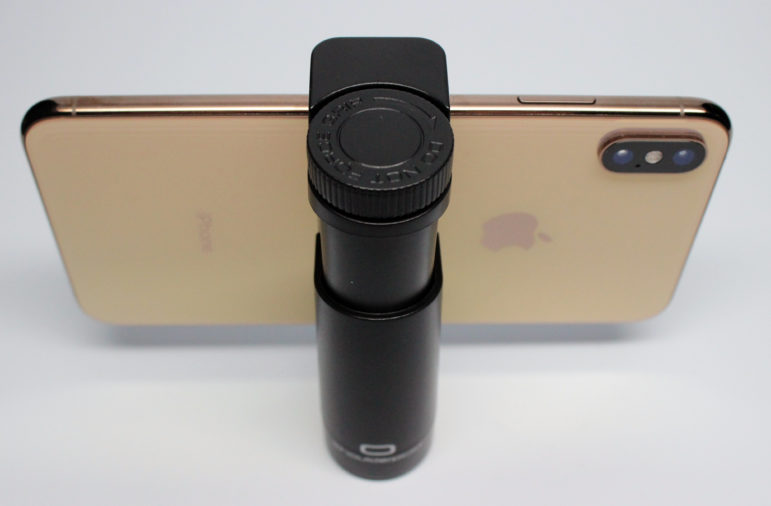
Jeremy Steele / Michigan State University School of Journalism
Your mobile reporting kit starts with a smartphone. Almost any modern smartphone – iPhone or Android – is great at taking photos and recording audio interviews in the field.
If you want to shoot video, pay attention the amount of memory available in a device. More memory allows you to shoot more video without having to move files as often onto a separate hard drive or cloud-based service. There’s nothing worse than being out in the field and running out of space on your device for more photos or video.
You also need a device that will allow you to connect to an external mic and power.
Generally, we’ve found that many of the apps used by journalists come out first for iPhone. But Android devices also have a wide range of apps that allow journalists to do their work.
If you have an iPhone without a headphone input, you may need a lightning-to-headphone jack adapter so that you can use corded mics with your device.
Smartphone mount
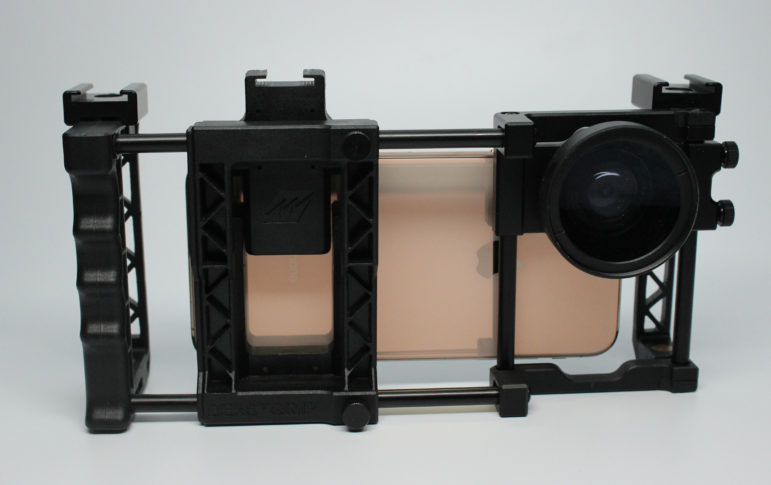
Jeremy Steele / Michigan State University School of Journalism
A smartphone mount or rig will allow you to securely attach your device to a tripod. Rigs used by professionals also provide additional stability for when shooting without a tripod, have options for lenses and hold a microphone and/or light.
A universal cellphone clamp will connect just about any size or brand of smartphone to a tripod. This may be a good option for a mount if your primary focus is something other than broadcast video work. Prices for a decent clamp start at about $10. Our experience is cheaper clamps — often made of thin plastic and wire — can break easily and do not securely hold your phone. Many clamps won’t let you attach other gear.
Students in the broadcast journalism minor should look at the iOgrapher case, Beastgrip Pro or similar a rig that will allow you to attach mics, lights and other equipment AND give you a stable hold when shooting without a tripod.
Recommended mounts
Universal cellphone clamp
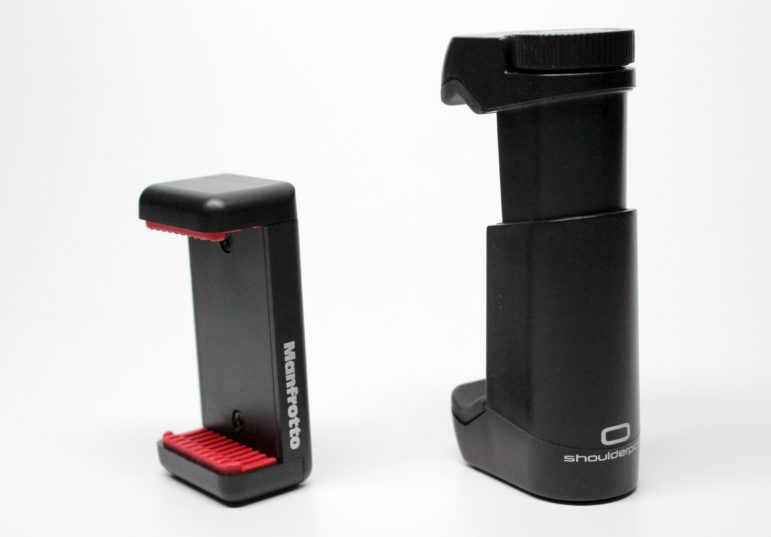
Jeremy Steele / Michigan State University School of Journalism
A clamp will allow you to connect your device to a tripod, but most don’t allow you to attach other gear (such as mics or lights). It also won’t help you get a better grip when doing handheld shots. But clamps can be an effective tool for those who only occasionally shoot video.
- Manfrotto’s universal phone mount is the least expensive option we recommend at $10-12. It is all plastic and some reviewers complain about it breaking if you’re not careful – but it comes from a reputable brand and holds devices securely.
- The Shoulderpod G1 or S1 ($25-$30) is solid and secure. The S1 has the same clamp as the G1, but comes with a small, detachable handle.
- The Movo PR-1 ($25) is similar to Shoulderpod S1, but it also includes a cold shoe mount for a shotgun microphone or light.
iOgrapher Cage
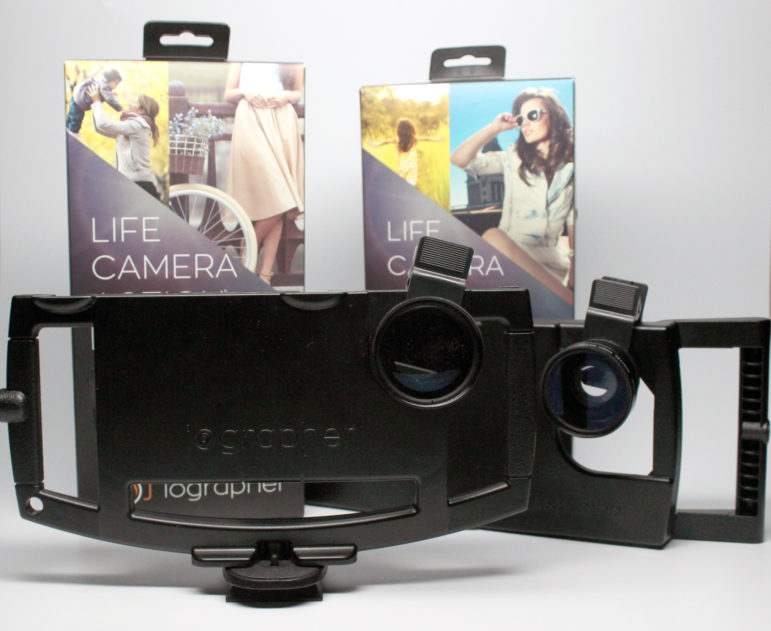
Jeremy Steele / Michigan State University School of Journalism
Cases and cages from iOgrapher offer an affordable option to give you a rig that securely holds your phone, has places to mount mics or lights and has big handles for steadier handheld shots; highly recommended for students in the broadcast journalist minor. The new Cage by iOgrapher is our current top pick and is available in a bundle for $115 when purchased with the discount code available from your journalism instructor.
- Get a supply bundle from iOgrapher. iOgrapher offers J-School students a discounted bundle with a case, mic, tripod and other accessories. Make sure you get the discount code from your professor for the best deal.
Beastgrip Pro
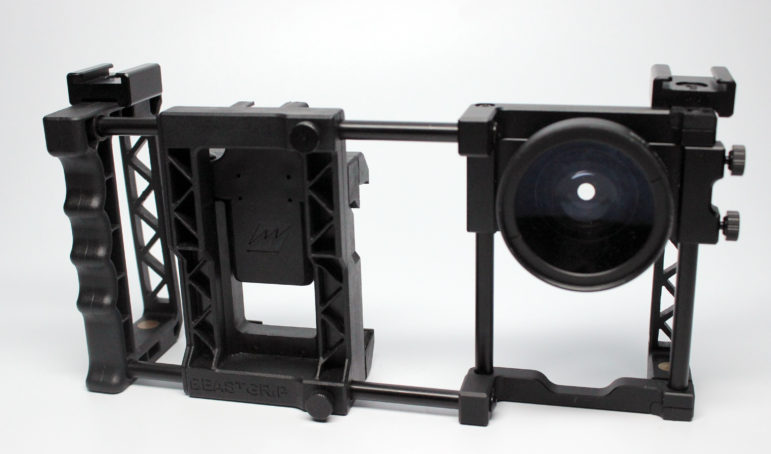
Jeremy Steele / Michigan State University School of Journalism
This is a high quality mount that will fit phones of multiple sizes and has a spot for lenses built in. It comes with one mount spot for a light or mic, with room to add cold shoe mounts. Two minor complaints we have: You’ll want to keep the Allen wrenches that come with it handy to occasionally tighten the screws, and we’ve found that students somehow find a way to bend the adjustable screws. Expect to spend about $166 for a Beastgrip mount bundled with a wide angle lens.
Microphone
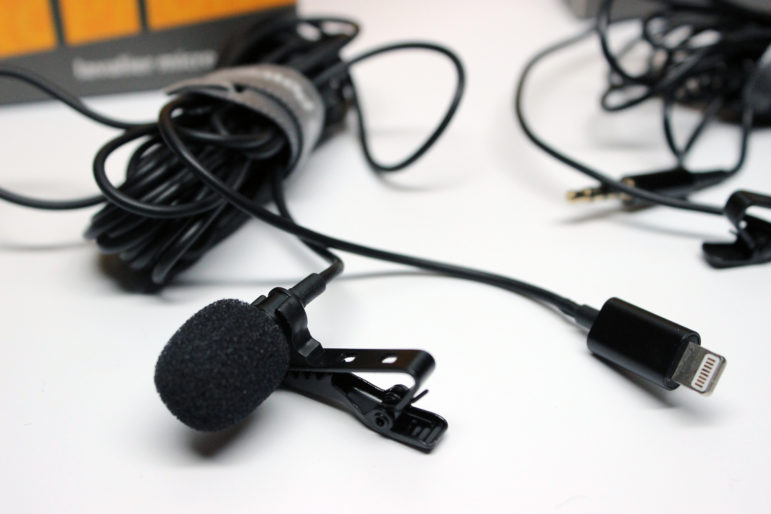
Jeremy Steele / Michigan State University School of Journalism
If you want professional quality media, you need to invest in an external microphone that plugs into your phone. The microphone in your smartphone simply won’t give you audio of high enough quality under most real-world conditions. Consult your professor about whether a specific type of microphone is required for your class.
A lavalier microphone is great for stand-ups or to use for interviews.
A shotgun microphone gives you some flexibility to move since it doesn’t attach to your interview subject. (This is a good option for interviews when practicing social distancing and often can be mounted to a pole to get the microphone closer to the interview source while you stay at least 6 feet away.)
A stick mic can sometimes be useful for “person-on-the-street” interviews, but probably would end up the least used mic in your kit. For that reason, we recommend you invest in a lav or shotgun mic first.
Recommended mics
Lavalier
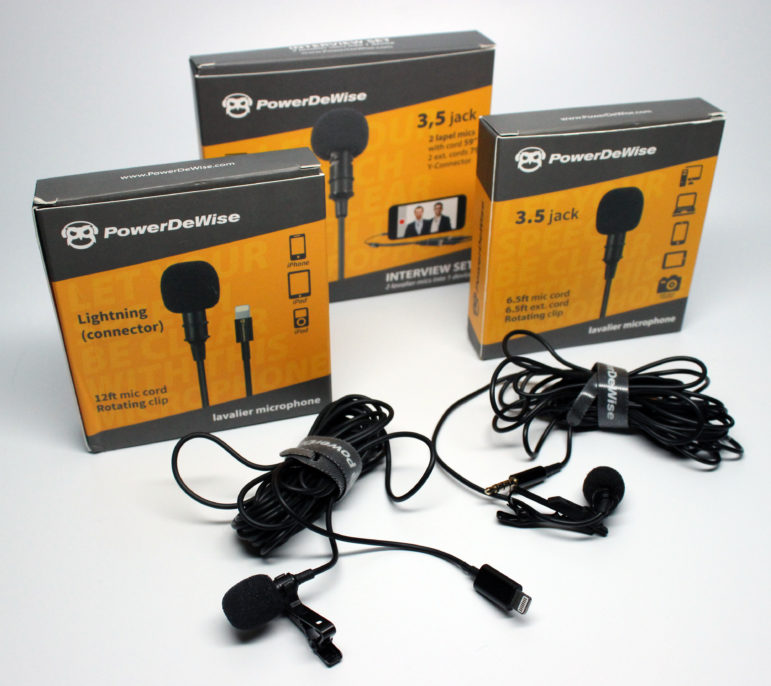
Jeremy Steele / Michigan State University School of Journalism
- A corded lavalier microphone is included in the iOgrapher bundle.
- PowerDeWise Professional Grade Lavelier can be found for under $25. It has a long cord and comes with an adapter to allow it to be used with a DSLR or video camera. This company also has a version with a lightning connector for about $30. We have had a couple of reports from students that their mic stopped working or didn’t work with their device. Still, this is the best mic we’ve found at this price point.
- iRig Mic Lav ($40-50) is another good smartphone-compatible mic, but you may find that you need to buy an extension cable.
- The Rode SmartLav mic is a highly rated wired smartphone lav ($64), but you’ll probably want to also buy the extension cable ($25).
- The Rode Wireless GO Compact Digital Wireless Microphone System ($199) is a nice wire-free upgrade to work with smartphones.
Shotgun mic
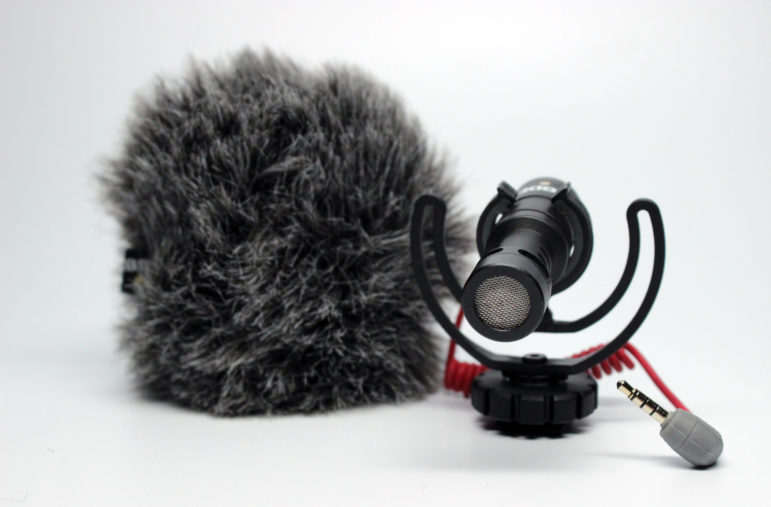
Jeremy Steele / Michigan State University School of Journalism
- The iOgrapher MicMini shotgun mic can be added to the MSU recommended the iOgrapher bundle used with smartphones or DSLR cameras. Required cables included.
- The Rode VideoMicro shotgun mic is a great add-on to your kit. It can help you capture natural sound and is more mobile than a wired lavalier mic. It can be attached to a mount or used with a DSLR. ($59) For use with the iPhone, you’ll need the TRS to TRRS patch cable ($15).
- Recommended add-on – Boom pole: Adding a boom pole to your kit can help you get better sound while practicing social distancing. You may need an extension cable for your corded mic.
Tripod
A shaky shot is a dead giveaway that an amateur is behind the camera. Invest in a tripod. The taller the tripod, generally, the better it is to use for stand-ups – but the harder it may be for you to carry around. A 42-inch tripod fits neatly into a backpack, but may only work for sit-down interviews. Most big-box stores and online retailers carry $20-$30 tripods. They can work for a basic setup, but they’re often just not built very well. They have a reputation for breaking if you’re moderately hard on your equipment and they’re awful if you try to do pans and tilts. Still, any tripod is better than no tripod.
Students in the broadcast journalism minor must have a tripod.
Recommended tripods
- The iOgrapher bundle discussed previously includes a good tripod.
- Magnus VT-100 Tripod System with 2-Way Pan Head extends to 59 inches. About $40.
- A mini tabletop tripod, like this one from Manfrotto, is a nice backup to tuck away in your bag. About $25.
Light
An external, on-camera light can help you produce better videos when you’re shooting inside or in dark areas. The Manfrotto Lumimuse 3 LED Light is good starting point. This light is small, light weight and dimmable. It’s available from iOgrapher and other vendors.
Textbook/Guide
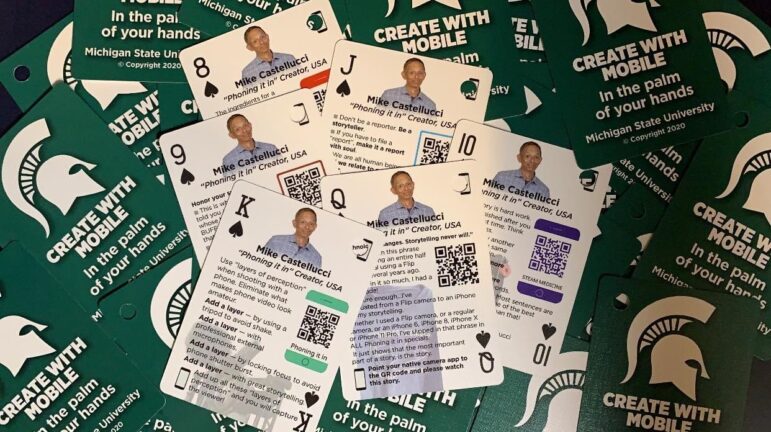
Jeremy Steele / Michigan State University School of Journalism
The Create With Mobile Project, created by Michigan State University School of Journalism Professor Mike Castellucci and communication and media consultant Dr. Len Clark, is a global journalism initiative built to inspire the next generation of smartphone journalists and storytellers. The Create with Mobile deck can be purchased at https://createwithmobile.com.Need help producing better quality videos with your mobile reporting kit? Invest in the Create with Mobile card deck, a non-traditional textbook with tips from mobile video journalists across the globe.
Portable hard drive
If you get into shooting much video, you’ll need somewhere to store all of those large files to keep from clogging up your smartphone or your computer. We recommend you invest in a portable hard drive to supplement the space on your own computer and/or to give you more flexibility to use ComArtSci’s computer labs. Look for a drive that’s 2 TB or larger with the right connector for your computer (USB, thunderbolt, USB-C, etc.). Make sure the drive is a portable hard drive so that it’s designed to be carried around with you and not simply sit on a desk.